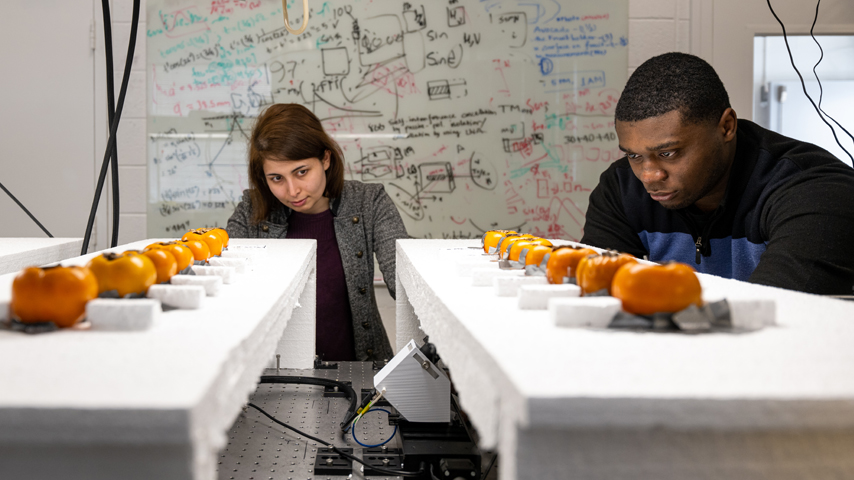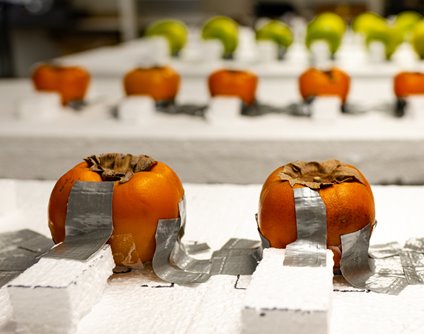Sensor Determines Produce Ripeness Instantly
Sensor Determines Produce Ripeness Instantly


Yasaman Ghasempour (left) and graduate student Atsutse Kludze led a team in developing a sensor to help farmers and consumers alike determine the best time to sell and purchase produce.
Imagine using your phone at the grocery store to determine which fruits and vegetables you’d like to purchase based off of their ripeness. Better yet, imagine the producer has already taken this step, ensuring that anything you buy has been checked for its freshness before being shipped to the store. Now, a team of researchers from Princeton University and Microsoft Research have designed a sensor that can do just that. In the future, the tech could not only reduce food waste, but save consumers money in the long run.
Yasaman Ghasempour, assistant professor of electrical and computer engineering at Princeton University, was motivated to develop the technology after learning just how inefficient agriculture can be. According to the National Resource Defense Council, up to 30 percent of farmers’ crops never make it to the market. Part of the problem is that farmers have strict guidelines for what is considered premium and sellable. Color, size, and blemishes all impact whether you will ever see a product on shelves. But above all, ripeness is the trickiest characteristic to determine with fruit.
“There are a few ways to test for ripeness,” explained Ghasempour. “The first is by extracting the juice of the fruit and using a sensor to measure the sugar concentration. This method is mostly used for grapes because they want to make sure that they’re harvesting the grapes at the perfect time. But it’s not a universal approach, it requires a dedicated tool, and that fruit is wasted. So it is not really a scalable in any way.”
There are a few other methods, such as using a camera to track color changes of the fruit, but that gives very little information about what is actually happening inside the fruit. There are also more traditional methods such as cutting the fruit, which also wastes the product and doesn’t give a full picture of the entire crop.
Better Harvesting: Robotic Gripper's Soft Touch Promises Gentler Blackberry Harvest Automation
Utilizing a background in sensor technology, the team’s first challenge was determining the signature and profile of a ripe fruit versus an unripe fruit.
“As the signal penetrates the peel and flesh of the fruit, you can imagine that each layer has some reflection, and the signal that reflects has some phase and amplitude,” Ghasempour said. “So we see a collection of these kinds of rays reflecting off of different layers in the fruit, and then we have a very hard job of trying to make sense of the profile that we see.”
To measure ripeness, the team had to identify metrics that would give them the most accurate picture of what was inside, she continued. They determined that the sugar percentage (referred to as brix) and the mass of the fruit (referred to as dry matter) are the best metrics.
“We know qualitatively that as the fruit matures, there are certain chemical interactions inside the fruit that are believed to increase density of sugar, making it sweeter,” she said. “As sugar presentation increases, dry matter also increases because as the fruit matures, it degenerates and then it saturates. There’s a sort of peak, and then as it overripens, you don't see much of a change in the values of brix and dry matter anymore.”
Once the team was able to identify these metrics, it became easier to determine the signature or profile for different types of fruit. They ran their experiments on five different fruits, which they measured over the course of 20 days. They checked the signatures every eight hours, from unripe to rotten. After gathering all of the data, they were able to determine the peak frequency at which the fruits would be most ripe.
Become a Member: How to Join ASME
The researchers also identified different classifications that would help producers make decisions about distribution. By being able to identify when a fruit was at its peak, they could say which fruits would take priority over others in getting to stores.
Another part of the project was to make it so that the consumer could also test fruit. To do this, the team developed a sticker that would be placed on the outside of individual fruits. The consumer would then scan the sticker using their phone and receive data on the fruit.
“The sticker is optimized for a certain resonance or starting peak frequency. As your substrate, or fruit, changes over time, the resonance frequency of the sticker on top of the fruit will also change,” Ghasempour said. “It's one single signature that will shift toward the right or left depending on the structure or ripeness of the fruit.”
In addition to the time and cost savings of this technology, there are also potential health benefits. Someone with diabetes or who must monitoring blood sugar may be able to use this technology to measure the sugar concentration of individual fruits, Ghasempour added.
You Might Also Enjoy: 5 Agricultural Robots Bringing Food to the Table
As the team continues to develop the technology, the main focus is scalability. They envision a scanner that could measure the ripeness of multiple fruits at once as they move along a conveyor belt. But it will take time to develop a powerful enough scanner to quickly and effectively achieve this.
The researchers are also scaling the technology to different types of fruit. Since all fruits have a different peak frequency, it will also take time to adapt this to different types of produce. Then in the very distant future, the team hopes to expand the technology to vegetables, meats, and other products like milk.
Ghasempour is most excited about the potential capabilities for consumers. As smart phone technologies continue to become more advanced, there will be new applications previously thought impossible—such as testing fruit ripeness.
“If I have a full spectrum for sensing, what can I do? A human cannot tell the brix and dry matter of fruit. We cannot see beneath the peel. So, this technology is going to bring us beyond human perception,” Ghasempour said.
Cassandra Kelly is a science and technology writer in Columbus, Ohio.
Yasaman Ghasempour, assistant professor of electrical and computer engineering at Princeton University, was motivated to develop the technology after learning just how inefficient agriculture can be. According to the National Resource Defense Council, up to 30 percent of farmers’ crops never make it to the market. Part of the problem is that farmers have strict guidelines for what is considered premium and sellable. Color, size, and blemishes all impact whether you will ever see a product on shelves. But above all, ripeness is the trickiest characteristic to determine with fruit.
“There are a few ways to test for ripeness,” explained Ghasempour. “The first is by extracting the juice of the fruit and using a sensor to measure the sugar concentration. This method is mostly used for grapes because they want to make sure that they’re harvesting the grapes at the perfect time. But it’s not a universal approach, it requires a dedicated tool, and that fruit is wasted. So it is not really a scalable in any way.”
There are a few other methods, such as using a camera to track color changes of the fruit, but that gives very little information about what is actually happening inside the fruit. There are also more traditional methods such as cutting the fruit, which also wastes the product and doesn’t give a full picture of the entire crop.
Better Harvesting: Robotic Gripper's Soft Touch Promises Gentler Blackberry Harvest Automation
Utilizing a background in sensor technology, the team’s first challenge was determining the signature and profile of a ripe fruit versus an unripe fruit.
“As the signal penetrates the peel and flesh of the fruit, you can imagine that each layer has some reflection, and the signal that reflects has some phase and amplitude,” Ghasempour said. “So we see a collection of these kinds of rays reflecting off of different layers in the fruit, and then we have a very hard job of trying to make sense of the profile that we see.”
To measure ripeness, the team had to identify metrics that would give them the most accurate picture of what was inside, she continued. They determined that the sugar percentage (referred to as brix) and the mass of the fruit (referred to as dry matter) are the best metrics.
“We know qualitatively that as the fruit matures, there are certain chemical interactions inside the fruit that are believed to increase density of sugar, making it sweeter,” she said. “As sugar presentation increases, dry matter also increases because as the fruit matures, it degenerates and then it saturates. There’s a sort of peak, and then as it overripens, you don't see much of a change in the values of brix and dry matter anymore.”
Once the team was able to identify these metrics, it became easier to determine the signature or profile for different types of fruit. They ran their experiments on five different fruits, which they measured over the course of 20 days. They checked the signatures every eight hours, from unripe to rotten. After gathering all of the data, they were able to determine the peak frequency at which the fruits would be most ripe.
Become a Member: How to Join ASME
The researchers also identified different classifications that would help producers make decisions about distribution. By being able to identify when a fruit was at its peak, they could say which fruits would take priority over others in getting to stores.
Another part of the project was to make it so that the consumer could also test fruit. To do this, the team developed a sticker that would be placed on the outside of individual fruits. The consumer would then scan the sticker using their phone and receive data on the fruit.
“The sticker is optimized for a certain resonance or starting peak frequency. As your substrate, or fruit, changes over time, the resonance frequency of the sticker on top of the fruit will also change,” Ghasempour said. “It's one single signature that will shift toward the right or left depending on the structure or ripeness of the fruit.”
In addition to the time and cost savings of this technology, there are also potential health benefits. Someone with diabetes or who must monitoring blood sugar may be able to use this technology to measure the sugar concentration of individual fruits, Ghasempour added.
You Might Also Enjoy: 5 Agricultural Robots Bringing Food to the Table
As the team continues to develop the technology, the main focus is scalability. They envision a scanner that could measure the ripeness of multiple fruits at once as they move along a conveyor belt. But it will take time to develop a powerful enough scanner to quickly and effectively achieve this.
The researchers are also scaling the technology to different types of fruit. Since all fruits have a different peak frequency, it will also take time to adapt this to different types of produce. Then in the very distant future, the team hopes to expand the technology to vegetables, meats, and other products like milk.
Ghasempour is most excited about the potential capabilities for consumers. As smart phone technologies continue to become more advanced, there will be new applications previously thought impossible—such as testing fruit ripeness.
“If I have a full spectrum for sensing, what can I do? A human cannot tell the brix and dry matter of fruit. We cannot see beneath the peel. So, this technology is going to bring us beyond human perception,” Ghasempour said.
Cassandra Kelly is a science and technology writer in Columbus, Ohio.
